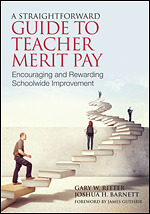A Straightforward Guide to Teacher Merit Pay
Encouraging and Rewarding Schoolwide Improvement
- Gary W. Ritter - University of Arkansas, USA
- Joshua H. Barnett - Arizona State University, USA
Foreword by James Guthrie, National Superintendents Roundtable
Reward your best teachers for the great work they do!
Is your school system considering teacher merit pay? Now is the time to understand the potential benefits and pitfalls of performance-based teacher pay, as well as how today’s most successful programs were developed. Drawing on substantial research with school districts, Gary Ritter and Joshua Barnett provide a step-by-step approach to setting up a merit pay system in your school district. Readers will find
- An overview of existing merit pay programs and their strengths and weaknesses
- A review of the 12 most common myths about merit pay, and how school leaders can respond
- Six guiding principles for designing a merit pay program, along with how-to’s and timelines for every phase
- Guidance on creating balanced assessments based on multiple measures of teacher effectiveness, and developed in collaboration with teachers
Ensure that your district’s merit pay program supports teachers’ professional growth, schoolwide progress, and student achievement.
“Ritter and Barnett bring much-needed researched clarity to this complex issue. For school administrators, education policy makers, legislators, and others interested in school reform, this book is a must-read.”
—Rod Paige, Former U.S. Secretary of Education
“This guide is a useful resource for undertaking merit pay, preventing pitfalls, and most importantly, offering solid recommendations for creating well-designed implementations.”
—Gary Stark, President and CEO
National Institute for Excellence in Teaching
"Gary Ritter and Joshua Barnett have captured and shared extensive information that provides historical background as it relates to and resulted in the current context of the public schools. A Straightforward Guide to Teacher Merit Pay has helped me process my thinking through four decades in the profession."
